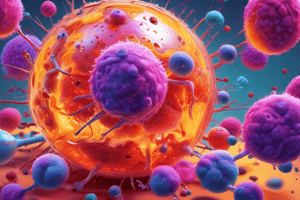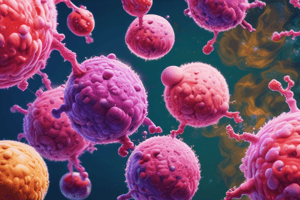Podcast
Questions and Answers
What is the main mechanism responsible for tissue injury in some forms of glomerulonephritis and vascular rejection in organ grafts?
What is the main mechanism responsible for tissue injury in some forms of glomerulonephritis and vascular rejection in organ grafts?
Antibody-mediated inflammation
In which disorder do antibodies against acetylcholine receptors inhibit neuromuscular transmission?
In which disorder do antibodies against acetylcholine receptors inhibit neuromuscular transmission?
Myasthenia gravis
What type of hypersensitivity reaction is characterized by immune complex deposition and tissue damage?
What type of hypersensitivity reaction is characterized by immune complex deposition and tissue damage?
Type III hypersensitivity
What is the prototype of cell-mediated inflammation in delayed-type hypersensitivity reactions?
What is the prototype of cell-mediated inflammation in delayed-type hypersensitivity reactions?
What type of cells produce substances that destroy microbes, damage tissues, and promote inflammation in type IV hypersensitivity reactions?
What type of cells produce substances that destroy microbes, damage tissues, and promote inflammation in type IV hypersensitivity reactions?
Flashcards are hidden until you start studying
Study Notes
Disorders of the Immune System
- The immune system is divided into three broad categories:
- Hypersensitivity reactions (immunologically mediated tissue injury)
- Autoimmune diseases
- Immunodeficiency diseases
Immunodeficiency
- Definition: inability to mount an effective immune response
- Primary immunodeficiency: genetically determined, inherited genetic disorders
- Secondary immunodeficiency: acquired, may arise from various diseases, infections, malnutrition, or side effects of treatments
Primary Immunodeficiency
- Impair mechanisms of innate immunity (phagocytes, NK cells, or complement) or adaptive immunity (B lymphocytes and T lymphocytes)
- Usually detected in infancy (6 months to 2 years)
- Signs: recurrent infections
- Examples:
- Severe combined immunodeficiency (SCID)
- Common variable immunodeficiency (CVID)
- X-linked agammaglobulinemia (XLA)
Severe Combined Immunodeficiency (SCID)
- Combination of genetically distinct syndromes
- Impaired development of mature T lymphocytes and/or B lymphocytes
- Defects in both humoral and cell-mediated immunity
- Signs: thrush (oral candidiasis), severe diaper rash, failure to thrive
- Susceptible to recurrent, severe infections
X-Linked Agammaglobulinemia (XLA)
- Failure of pre–B cells to differentiate into mature B cells
- Resultant absence of antibodies (gamma globulin) in the blood
- Frequency: about 1 in 100,000 male infants
Common Variable Immunodeficiency (CVID)
- Heterogeneous group of disorders
- Hypogammaglobulinemia affecting all antibody classes (sometimes only IgG)
- Normal numbers of mature B cells, but plasma cells are absent
- B cell areas of lymphoid tissues tend to be hyperplastic
Causes of Primary Immunodeficiency
- Genetic mutations affecting immune cell development, function, or regulation
- Defects in specific components of the immune system (T cells, B cells, phagocytes)
- Inherited disorders of immune regulation (autoimmune lymphoproliferative syndrome, hyper-IgE syndrome)
Secondary Immunodeficiency
- Acquired conditions that compromise immune function due to external factors or underlying diseases
- Examples:
- Protein deficiency
- Hematologic malignancies (leukemia, lymphoma)
- Acute viral infections (infectious mononucleosis)
- Chronic renal failure
- Iatrogenic (steroids, cytotoxic drugs, radiotherapy)
- Splenectomy
- Acquired Immunodeficiency Syndrome (AIDS)
Hypersensitivity Reactions
- Exaggerated or inappropriate immune responses to harmless antigens
- Overview of four types of hypersensitivity reactions (I-IV) and their underlying mechanisms
Type I Hypersensitivity
- Immediate hypersensitivity, mediated by IgE antibodies and mast cell activation
- Reaction occurs rapidly (within minutes) after the interaction of antigen with IgE antibody bound to the surface of mast cells
- Examples: seasonal rhinitis, hay fever, asthma, anaphylaxis
Type II Hypersensitivity
- Antibody-mediated hypersensitivity disorders
- Mechanisms:
- Opsonization and phagocytosis
- Inflammation
- Antibody-mediated cellular dysfunction
- Examples:
- Transfusion reactions
- Hemolytic disease of the newborn
- Autoimmune hemolytic anemia, agranulocytosis, and thrombocytopenia
- Certain drug reactions
Type III Hypersensitivity
- Immune complex-mediated hypersensitivity reactions
- Characterized by immune complex deposition and tissue damage
- Examples:
- Serum sickness
- Arthus reaction
- Rheumatoid arthritis
- Systemic lupus erythematosus
Type IV Hypersensitivity
- Delayed-type hypersensitivity reactions
- Mediated by CD4+ T cells and cytokines
- Characterized by chronic inflammation
- Examples:
- Contact dermatitis
- Tuberculin reaction
- Granulomatous reactions
- Chronic inflammatory diseases
Studying That Suits You
Use AI to generate personalized quizzes and flashcards to suit your learning preferences.




